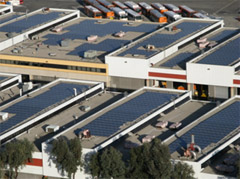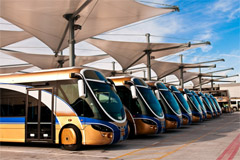Contact Pacific Southwest Waste Program
Pacific Southwest, Region 9
Serving: Arizona, California, Hawaii, Nevada, Pacific Islands, Tribal Nations
Transit Goes Green
BART Riders Get the Equivalent of 249 Miles Per Gallon
A typical car gets 20.3 miles per gallon (mpg). During the peak hour BART is 12 times more efficient on a passenger miles per gallon basis than a typical single occupant vehicle. A BART rider gets the equivalent of 249 miles per gallon. Not even the most fuel efficient hybrid can match that. BART is 5 to 6 times more efficient during the high occupancy peak hour than the most popular hybrid vehicle getting 45 mpg.
BART trains are 100% electric. 67% of power comes from clean hydro and renewable sources.
For its length, the BART car is the lightest mass transit rail car in the world, which reduces energy consumption.
Source: BART Green Factsheet (PDF)
![]()
Learn More About
Sustainable Transit
Transit Partners
San Francisco Bay Area Rapid Transit District (BART)
Chicago Transit Authority (CTA)
Los Angeles Metro (LA Metro)
Metropolitan Atlanta Rapid Transit Authority (MARTA)
Miami Dade Transit (MDT)
New York City Transit (NYCT)
Regional Transportation District of Denver (RTD)
Regional Transportation Commission of Southern Nevada (RTC)
Toronto Transit Commission (TTC)
South Coast British Columbia Transportation Authority of Vancouver (TransLink)
Tri-County Metropolitan Transportation District of Portland (TriMET)
Washington DC Metropolitan Area Transit Authority (WMATA)

On this page:
A new Sustainable Transit Standard was recently approved by the American Public Transportation Association. The standard brings transit-specific sustainability guidance to the development, building, and operations of trains, buses, and ferry systems.
Work on sustainable transit supports the HUD-DOT EPA Sustainable Communities Partnership developed to improve access to affordable housing, expand transportation options, and lower transportation costs while protecting the environment in communities nationwide.
This new set of guiding principles will help lead America's transit industry to support broader environmental stewardship. Removing barriers to innovation, inducing smart growth, and increasing transit ridership will reduce air pollution, noise pollution, and greenhouse gas emissions.
“The development of a sustainable transit standard will make riding transit ultra-green!” said Timonie Hood, Green Building Coordinator for EPA’s Pacific Southwest Office. “We greatly appreciate the efforts of APTA, BART and the transit visionaries who worked together to develop this transit-map for sustainability.”
The APTA Sustainable Transit Standard was distilled from Sustainable Transit Guidelines and was developed, in part, with EPA funding and technical support. The work on the Sustainable Transit Guidelines was led by the San Francisco Bay Area Rapid Transit (BART). The BART team conducted a comprehensive green overhaul of BART’s facility standards and organized a workgroup of multi-modal North American transit leaders that developed detailed guidelines and case studies. Jennifer Blonn, a High Speed Rail Coordinator for EPA’s Pacific Southwest Office, worked at BART to help develop the guidelines.
The standard's development team is working with California High-Speed Rail to define and implement high impact aspects of transit sustainability. “APTA adopted the Transit Sustainability Guidelines as an industry standard with great vision and at a critical time to support the nation-wide high speed rail initiative,” said Tian Feng, chief editor of the standard and District Architect of BART. The new transit standard incorporates green building standards, and goes beyond buildings to cover system routes, infrastructure, rolling stock and fleet, as well as operations and maintenance. Sustainability elements include:
- Smart Land Use & Livable Communities
- Materials, Construction/Operations Optimization
- Energy & Resource Efficiency
- Quality of Ambient Environment & Health
- Emissions & Pollution Control
Sustainable Transit in Action
Sustainable Materials and Recycling

BART replaced petroleum-based track lubricating oil with biodegradable soybean oil. The sustainable transit leader also saved over $711,000 in landfill disposal fees by requiring the recycling construction and demolition debris. BART replaced over 1200 chemically treated wooden railroad ties with recycled plastic railroad ties made from 3.3 million grocery bags and 739,000 plastic bottles. The transit agency’s comprehensive sustainability initiatives are documented in EPA Innovations Work Group grant reports
Mega-Solar Energy

Los Angeles METRO ![]() installed the nation's largest solar panel system at a transit facility. The 6,720 individual solar panels at Metro's Support Services Center in downtown Los Angeles cover the central 400,000 square foot maintenance facility for buses. The solar system will generate 1.2 megawatts of renewable, emission-free power. Along with other energy-efficient improvements, the project cut the facility's $1.1 million energy bill by $646,000 to approximately $454,000 annually. This shift to renewable energy reduced annual carbon emissions by more than 4,300 metric tons.
installed the nation's largest solar panel system at a transit facility. The 6,720 individual solar panels at Metro's Support Services Center in downtown Los Angeles cover the central 400,000 square foot maintenance facility for buses. The solar system will generate 1.2 megawatts of renewable, emission-free power. Along with other energy-efficient improvements, the project cut the facility's $1.1 million energy bill by $646,000 to approximately $454,000 annually. This shift to renewable energy reduced annual carbon emissions by more than 4,300 metric tons.
Specialized Bus Rapid Transit

The Regional Transportation Commission of Southern Nevada ![]() operates unique Bus Rapid Transit vehicles to provide faster service with fewer stops. The hybrid-diesel vehicles increased ridership 280% in the first year and have carried more than 5 million passengers in cleaner and greener vehicles.
operates unique Bus Rapid Transit vehicles to provide faster service with fewer stops. The hybrid-diesel vehicles increased ridership 280% in the first year and have carried more than 5 million passengers in cleaner and greener vehicles.
BART, in the San Francisco Bay Area, is one of the largest transit authorities in the nation, and one of the most prominent inter-city transit authorities in the world. BART has more than 100 million riders per year and led the Sustainable Transit Guideline and Standard development.
APTA is a nonprofit international association of over 1,500 public and private member organizations including transit systems and commuter rail operators; planning, design, construction and finance firms; product and service providers; academic institutions, transit associations and state departments of transportation. APTA standards are used to achieve operational efficiencies and safety improvements ![]() in services, facilities and vehicles.
in services, facilities and vehicles.
Make A Difference – Ride Sustainable Transit
Riding transit instead of driving is something each one of us can to do protect the environment, and transit is becoming even greener through this groundbreaking work on sustainable transit. Get on board!
